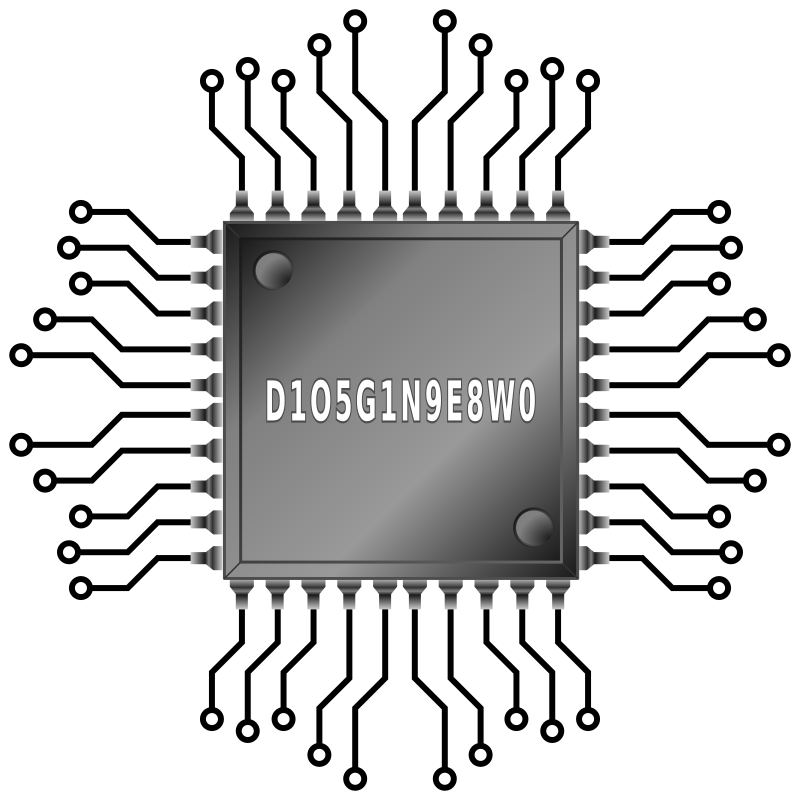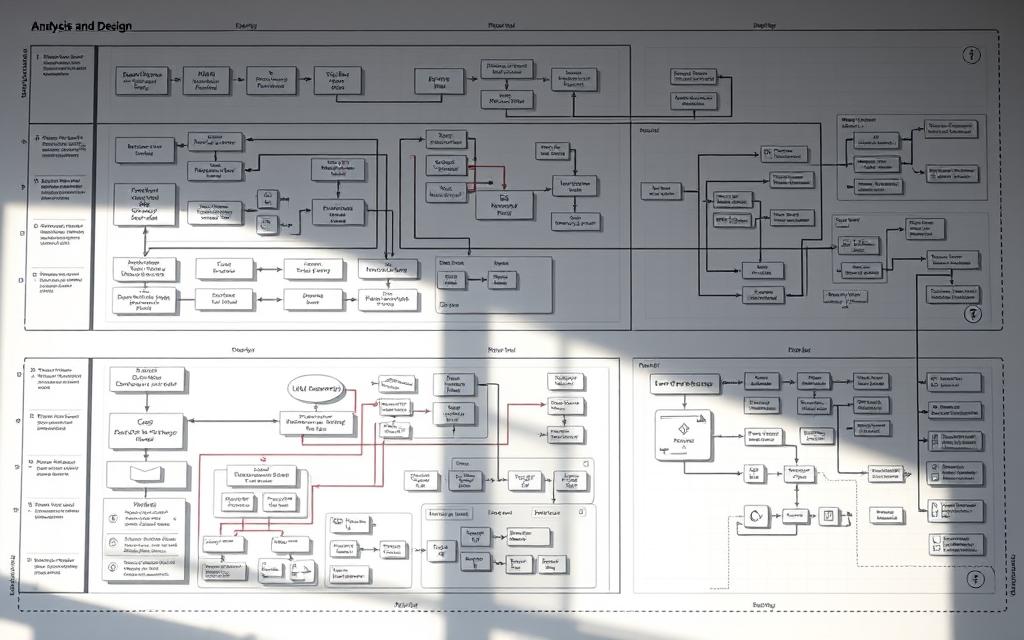System Analysis and Design (SAD) is a structured methodology used to develop or improve technical and organizational frameworks. It originated in the mid-20th century, influenced by pioneers like Norbert Wiener and Joseph Juran, who focused on operational efficiency and quality management.
This approach combines technical expertise with managerial strategies to identify problems, analyze requirements, and implement effective solutions. It plays a crucial role in industries such as IT, healthcare, and transportation, ensuring alignment between technology and business objectives.
By focusing on interconnectedness and feedback loops, SAD supports digital transformation initiatives. Unlike ad-hoc problem-solving, it provides a clear process for achieving measurable outcomes. This makes it essential for organizations aiming to optimize their operations and achieve long-term success.
Introduction to System Analysis and Design
Understanding complex frameworks requires a structured approach to identify and solve challenges. This is where systems thinking comes into play. It focuses on how different elements interact within a larger framework, ensuring all parts work together seamlessly.
The Systems Development Life Cycle (SDLC) is a key process in this field. It includes phases like planning, analysis, design, deployment, and maintenance. The analysis stage involves understanding requirements, while the design phase focuses on creating effective solutions.
An analyst plays a crucial role in bridging technical and business needs. They ensure that the final solution aligns with organizational goals. Collaboration with stakeholders is essential to gather accurate requirements and ensure smooth execution.
Key deliverables include requirement specifications and system models. These documents provide a clear roadmap for the project. Modern approaches are iterative, allowing for continuous improvement and adaptation.
Legacy system modernization presents unique challenges. Tools like data flow diagrams and UML help visualize complex processes. Methodologies like Agile and Waterfall offer different approaches to managing projects effectively.
| Phase | Focus |
|---|---|
| Analysis | Understanding requirements |
| Design | Creating solutions |
Differentiating between analysis and design phases is critical. Analysis identifies the problem, while design provides the solution. Both are essential for successful project management and communication.
What Is System Analysis and Design in Computer?
Computer-based frameworks demand tailored approaches for seamless hardware-software integration. These methodologies ensure compatibility, scalability, and efficient performance across diverse applications. From automatic library systems to railway reservation platforms, structured processes are essential for success.
Key considerations include interoperability and scalability. Systems must work across different platforms while accommodating growth. Hardware-software co-design ensures that both components align to meet specific requirements.
Data architecture principles focus on organizing and managing information effectively. Network topology impacts how components communicate, influencing overall system performance. User interfaces and experience (UI/UX) play a vital role in ensuring accessibility and satisfaction.
Security design is imperative to protect sensitive information. Embedded systems, like those in medical devices, differ from application systems, such as point-of-sale (POS) platforms. Legacy system integration presents unique challenges, requiring careful planning and execution.
Cloud computing introduces new possibilities for scalability and flexibility. Modern methodologies adapt to these advancements, ensuring systems remain efficient and secure.
| Consideration | Description |
|---|---|
| Interoperability | Ensures systems work across platforms |
| Scalability | Supports growth and expansion |
| Security | Protects sensitive data |
| UI/UX | Enhances user accessibility and satisfaction |
By addressing these factors, organizations can develop robust frameworks that meet evolving demands. Structured methodologies provide a clear roadmap for achieving measurable outcomes.
The History and Evolution of System Analysis and Design
The roots of structured problem-solving trace back to mid-20th-century innovations. During this period, pioneers like Norbert Wiener and Joseph Juran introduced groundbreaking concepts. Wiener’s work on cybernetics in 1948 and Juran’s quality management principles in 1951 laid the foundation for modern methodologies.
In the 1940s, operations research emerged from WWII logistics challenges. This approach focused on optimizing resources and processes. By the 1950s, the transition to computer-based frameworks began, formalizing the term “systems analysis” through RAND Corporation military projects.

The 1960s saw the influence of structured programming, while the 1970s marked the rise of software engineering as a discipline. The 1980s brought the object-oriented design revolution, transforming how frameworks were developed. By the 1990s, web systems and distributed computing became prominent.
In the 2000s, Agile methodology gained traction, emphasizing flexibility and collaboration. The 2010s introduced DevOps and continuous integration, streamlining development and deployment. Today, AI-assisted design is shaping the future of structured problem-solving.
Early Pioneers and Contributions
Norbert Wiener’s cybernetics explored feedback loops and control mechanisms. Joseph Juran’s quality management principles emphasized continuous improvement. Their contributions shaped the tools and processes used in modern industries.
| Decade | Key Development |
|---|---|
| 1940s | Operations Research roots |
| 1950s | Computer-based systems analysis |
| 1960s | Structured programming |
| 1970s | Software engineering discipline |
| 1980s | Object-oriented design |
| 1990s | Web systems and distributed computing |
| 2000s | Agile methodology |
| 2010s | DevOps and continuous integration |
| 2020s | AI-assisted design |
From banking systems to healthcare platforms, the evolution of structured frameworks has transformed industries. Modern trends like AI-assisted design continue to push boundaries, ensuring adaptability and efficiency in a rapidly changing world.
Key Characteristics of Modern Systems
Modern digital frameworks rely on dynamic interactions between components to achieve efficiency. These frameworks prioritize adaptability, ensuring seamless performance across diverse environments. Four core traits define their success: interconnectedness, purpose, boundaries, and feedback loops.
Interconnectedness in Systems
IoT ecosystems exemplify how elements like sensors and cloud platforms interact. APIs act as bridges, enabling real-time data flow between applications. For instance, smart city infrastructure integrates traffic lights, GPS, and emergency services into a unified network.
Security risks increase with connectivity. Robust architecture must address vulnerabilities in cross-platform communication. Machine learning systems use feedback loops to refine predictions, enhancing performance over time.
Purpose and Boundaries
Healthcare systems focus on patient outcomes, guiding processes like electronic records management. Clear objectives prevent scope creep, as seen in e-commerce platforms with defined checkout workflows.
Cloud computing introduces boundary challenges. Regulatory compliance, such as GDPR, dictates data storage locations. Below is a comparison of open vs. closed systems:
| System Type | Key Trait | Example |
|---|---|---|
| Open | Flexible interfaces | API-driven apps |
| Closed | Strict boundaries | Medical devices |
HVAC control systems demonstrate feedback-driven adjustments. Sensors monitor temperature, triggering updates to maintain comfort. This cyclical flow ensures optimal operation with minimal manual intervention.
The System Analysis Process
Effective problem-solving in technical environments relies on a structured seven-phase process. This approach ensures clarity, efficiency, and measurable outcomes. Each phase builds on the previous one, creating a seamless workflow.

Problem Identification and Requirements Gathering
The first step involves identifying the core issue. Stakeholder analysis techniques help gather insights from key participants. Interviews and surveys are common tools for collecting accurate information.
Requirements prioritization frameworks ensure that critical needs are addressed first. Use case development processes map out user interactions, providing a clear understanding of expectations. Data modeling best practices organize information for easy access and interpretation.
System Design and Implementation
Once requirements are defined, the design phase begins. Prototyping methodologies allow for testing concepts before full-scale development. Change management strategies ensure smooth transitions during implementation.
Traceability matrices track progress, linking requirements to design elements. Risk assessment protocols identify potential challenges, while cost-benefit analysis models evaluate project feasibility. Documentation standards maintain consistency throughout the process.
| Phase | Key Focus |
|---|---|
| Problem Identification | Defining the core issue |
| Requirements Gathering | Collecting stakeholder needs |
| Design | Creating system solutions |
| Implementation | Deploying the system |
| Testing | Ensuring functionality |
| Deployment | Launching the system |
| Maintenance | Ongoing support and updates |
By following this structured process, teams can deliver robust solutions that meet user needs. Each phase contributes to the overall success of the project, ensuring alignment with organizational goals.
System Analysis vs. System Design
Exploring the differences between analysis and design reveals their unique roles in technical projects. While both are essential for successful project execution, they serve distinct purposes and require different skill sets. Understanding these distinctions helps teams allocate resources effectively and achieve measurable outcomes.

Focus and Objectives
System analysis focuses on understanding problems and gathering requirements. It involves identifying stakeholder needs and defining the scope of a project. Deliverables from this phase include requirement specifications and use case documents.
In contrast, system design centers on creating solutions. It translates requirements into actionable plans, producing architecture diagrams and workflow models. This phase ensures that the final product aligns with business goals and technical constraints.
Comparative Analysis Using RACI Matrix
A RACI matrix clarifies roles and responsibilities during both phases. In analysis, the analyst is accountable for gathering requirements, while stakeholders are consulted for input. During design, architects take the lead, with developers responsible for implementation.
| Phase | Accountable | Responsible | Consulted | Informed |
|---|---|---|---|---|
| Analysis | Analyst | Stakeholders | Developers | Management |
| Design | Architect | Developers | Analyst | Stakeholders |
Timeline and Skill Set Differences
Analysis is often front-loaded, requiring strong communication and problem-solving skills. Design, however, is iterative, demanding creativity and technical expertise. Tools like Jira are used for tracking analysis tasks, while Figma aids in visualizing design concepts.
Documentation and Stakeholder Involvement
Analysis produces requirement documents, while design generates architecture blueprints. Stakeholders are heavily involved in the analysis phase to ensure accurate requirements. During design, their role shifts to reviewing and approving proposed solutions.
Risk Profiles and Success Metrics
Analysis risks include incomplete requirements, while design risks involve technical feasibility. Success in analysis is measured by clarity of requirements, whereas design success is judged by functionality and scalability.
Case Study: ERP System Development
In an ERP project, analysis identified the need for integrated inventory management. Design translated this into a modular architecture, ensuring scalability. The transition between phases was managed through regular stakeholder reviews and iterative prototyping.
The Importance of System Analysis and Design
Structured methodologies play a pivotal role in enhancing operational efficiency across industries. They provide a clear framework for identifying challenges, gathering requirements, and implementing effective solutions. This approach ensures that organizations can achieve measurable outcomes while aligning with their strategic goals.

Applications in Business, Healthcare, and IT
In the business sector, these methodologies drive significant efficiency gains. For instance, documented implementations have shown a 35% improvement in operational performance. Supply chain optimization and customer experience transformation are just two examples of how structured approaches deliver tangible results.
Healthcare systems benefit immensely from structured methodologies. Electronic Health Record (EHR) systems, for example, have reduced medication errors by 27%. This directly enhances patient safety and improves overall care quality. Compliance with regulatory standards is another critical advantage, ensuring that organizations meet industry requirements seamlessly.
The technology sector leverages these methodologies to achieve scalability and cybersecurity improvements. Startups, in particular, use structured frameworks to grow rapidly while maintaining robust security postures. Disaster recovery planning and mergers & acquisitions integration are also streamlined through these approaches.
- ROI analysis of structured implementations highlights cost-effectiveness.
- Compliance benefits ensure adherence to industry regulations.
- Disaster recovery planning minimizes downtime during crises.
- Scalability achievements support growth in tech startups.
- Patient safety enhancements improve healthcare outcomes.
- Supply chain optimization boosts operational efficiency.
- Customer experience transformation drives loyalty.
- Cybersecurity improvements protect sensitive information.
- Mergers & acquisitions integration ensures smooth transitions.
- Sustainability impact assessments promote eco-friendly practices.
By adopting structured methodologies, organizations across industries can achieve long-term success. These frameworks not only solve immediate challenges but also prepare businesses for future growth and innovation.
Example of System Analysis and Design in Action
A real-world example demonstrates how structured frameworks drive efficiency in technical projects. A case study involving project management software highlights the transformative impact of these methodologies. By implementing a Gantt chart, task completion rates improved by 40%. Integration with Slack reduced communication delays by 65%, showcasing the power of seamless interfaces.
Requirement Gathering and System Modeling
The first phase involved stakeholder workshops to gather requirements. User story mapping processes helped define clear objectives. Architectural decision records ensured alignment with data and engineering standards. This phase laid the foundation for the project’s success.
Key deliverables included detailed diagrams and workflow models. These tools provided a visual representation of the project’s architecture. By prioritizing stakeholder needs, the team ensured that the final solution met user expectations.
System Design and Integration
During the design phase, the team analyzed microservices versus monolithic components. A CI/CD pipeline was implemented to streamline development. Load testing results validated the system’s performance under stress. User training programs were developed to enhance the overall experience.
Post-implementation reviews measured the project’s ROI. The integration of Slack and Gantt charts demonstrated the value of structured methodologies. Below is a summary of the project’s key outcomes:
| Metric | Improvement |
|---|---|
| Task Completion | 40% increase |
| Communication Delays | 65% reduction |
| User Satisfaction | 25% improvement |
| ROI | 30% higher than projected |
This case study underscores the importance of structured frameworks in achieving measurable outcomes. By focusing on project goals and leveraging modern software, organizations can drive efficiency and innovation.
Conclusion
Structured methodologies continue to shape the future of technical frameworks. With 78% of organizations reporting faster digital transformation, the value of these approaches is undeniable. Emerging trends, like AI-assisted tools, are revolutionizing the process, offering smarter solutions for complex challenges.
Career opportunities in this field are expanding, driven by the need for skilled professionals. Continuing education resources, such as certifications and workshops, help individuals stay ahead. Assessing organizational maturity ensures alignment with strategic objectives, fostering long-term success.
Global case studies highlight measurable improvements in performance and efficiency. As technology evolves, quantum computing promises to redefine possibilities. Implementing structured frameworks today prepares businesses for tomorrow’s innovations.
Adaptive systems remain at the core of progress. By embracing these methodologies, organizations can achieve sustainable growth and competitive advantage. The journey toward digital excellence starts with a commitment to structured design and analysis.










